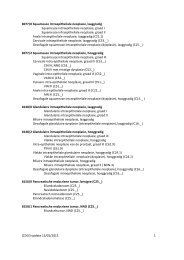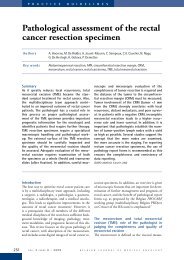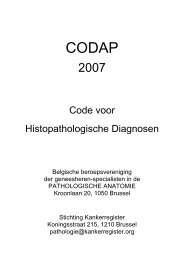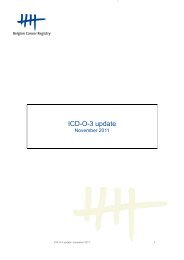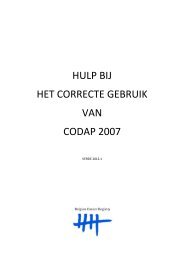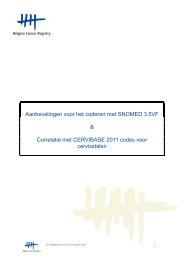Assurance de qualité pour le cancer rectal – phase 2 ...
Assurance de qualité pour le cancer rectal – phase 2 ...
Assurance de qualité pour le cancer rectal – phase 2 ...
You also want an ePaper? Increase the reach of your titles
YUMPU automatically turns print PDFs into web optimized ePapers that Google loves.
KCE Reports 81 PROCARE <strong>–</strong> <strong>phase</strong> 2 132.2.2.8 Quality indicators related to histopathologic examinationSix QI related to histopathologic were se<strong>le</strong>cted:• Use of the pathology report sheet (QI 1271) (expert opinion)• Quality of TME assessed according to Quirke and mentioned in thepathology report (QI 1272) (low <strong>le</strong>vel of evi<strong>de</strong>nce)• Distal tumour-free margin mentioned in the pathology report (QI 1273)(low <strong>le</strong>vel of evi<strong>de</strong>nce)• Number of lymph no<strong>de</strong>s examined (QI 1274) (low <strong>le</strong>vel of evi<strong>de</strong>nce)• (y)pCRM mentioned in mm in the pathology report (QI 1275) (low <strong>le</strong>velof evi<strong>de</strong>nce)• Tumour regression gra<strong>de</strong> mentioned in the pathology report (afterneoadjuvant treatment) (QI 1276) (low <strong>le</strong>vel of evi<strong>de</strong>nce)For most of the se<strong>le</strong>cted QI on pathology, no QI were i<strong>de</strong>ntified in the literature. Thefinal se<strong>le</strong>ction is therefore primarily based on the PROCARE recommendations [1].Only for QI 1274, several QI were found in the literature [5, 6]. The pathologist shouldfind as many lymph no<strong>de</strong>s as possib<strong>le</strong>. The median number found is an indication of thequality of the pathological examination. I<strong>de</strong>ally, it should exceed 12 lymph no<strong>de</strong>s [1].During the first external expert meeting of this project, it was suggested to use thementioning of the (y)pTN in the pathology report as a QI. However, to our opinion thisis not a QI, since it has no direct relation with the quality of care. Neverthe<strong>le</strong>ss, it isessential information for stage grouping and adjustment, and resultantly for thecalculation of many se<strong>le</strong>cted QI. Therefore, this information will always be reportedalong the results of the QI where re<strong>le</strong>vant.2.3 DISCUSSIONIn total, 40 QI were se<strong>le</strong>cted covering all aspects of the management of <strong>rectal</strong> <strong>cancer</strong>and representing a balanced mix of process and outcome indicators. The se<strong>le</strong>ction ofthese QI was based on a literature search and comp<strong>le</strong>ted with QI based on thePROCARE recommendations [1]. No formalised procedure was used to se<strong>le</strong>ct the QI,but on different occasions the se<strong>le</strong>ction was discussed with a multidisciplinary expertpanel. Above this, the se<strong>le</strong>ction was approved by the PROCARE board and an externa<strong>le</strong>xpert panel. The final se<strong>le</strong>ction is therefore consi<strong>de</strong>red very re<strong>le</strong>vant.Several se<strong>le</strong>cted (mainly outcome) QI are also re<strong>le</strong>vant for other <strong>cancer</strong>s, such as 5-yearsurvival, local recurrence rate, multidisciplinary discussion, time to treatment, rate of(late) gra<strong>de</strong> 4 chemotherapy and/or radiotherapy-related complications, proportion ofR0 resections, and the inpatient or 30-day mortality. The routine registration of theseparameters for all <strong>cancer</strong>s would therefore be of high re<strong>le</strong>vance for the measurement ofthe quality of care in oncology.The final QI se<strong>le</strong>ction represents the current state of the art according to thePROCARE recommendations [1]. In view of the changing evi<strong>de</strong>nce, this QI set willprobably need an update in about 5 years.



